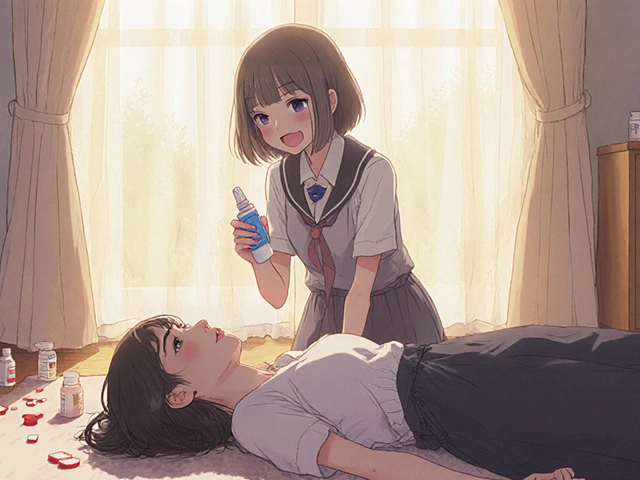
Potassium-Sparing Diuretic Comparison Tool
Select your primary condition:
Do you have kidney disease?
Are you concerned about hormonal side effects?
What is your budget consideration?
Quick Takeaways
- Spironolactone (Aldactone) blocks aldosterone and also cuts down androgen effects, making it popular for hypertension, heart failure, acne and hirsutism.
- Common alternatives - eplerenone, amiloride and triamterene - share the potassium‑sparing diuretic class but differ in selectivity, side‑effect profile and cost.
- Choose eplerenone if you need a cleaner cardiac‑protective profile with fewer hormonal side effects.
- Amiloride and triamterene are cheaper, work best when combined with thiazide‑type diuretics, and are useful for mild fluid retention.
- Match the drug to your primary condition, kidney function and tolerance for hormonal changes.
Spironolactone is a synthetic steroid that acts as a potassium‑sparing diuretic and an anti‑androgen. Marketed under the brand name Aldactone, it blocks the hormone aldosterone, reduces fluid buildup, and inhibits androgen receptors. Doctors prescribe it for conditions ranging from high blood pressure to acne in women.
How Spironolactone Works
Imagine aldosterone as a thermostat that tells your kidneys to hold onto salt and water. Spironolactone flips that thermostat off, letting excess fluid flow out while keeping potassium in the bloodstream. At the same time, it slides into androgen receptors, dampening the effects of male hormones that can cause unwanted hair growth or oily skin.
When People Reach for Aldactone
- Hypertension - especially when other meds haven’t fully controlled blood pressure.
- Heart failure - improves survival by reducing ventricular strain.
- Primary hyperaldosteronism - corrects the excess aldosterone production.
- Acne and hirsutism in women - the anti‑androgen effect clears skin and slows unwanted hair.
Key Benefits
Spironolactone’s dual action means you can hit two birds with one pill: lower blood pressure and treat hormone‑related skin issues. It also helps retain potassium, which many other diuretics dump, reducing the risk of low‑potassium cramps.
Typical Side Effects
- Elevated potassium (hyperkalaemia) - watch labs if you have kidney disease.
- Gynecomastia or breast tenderness in men.
- Menstrual irregularities in women.
- Dizziness or mild gastrointestinal upset.
Alternative Potassium‑Sparing Diuretics
Below are the most common drugs that sit in the same class but have different personalities.
Eplerenone is a newer, more selective aldosterone blocker that spares you many of spironolactone’s hormonal quirks.
Amiloride is a simple sodium channel blocker; it’s often paired with thiazide diuretics to keep potassium steady.
Triamterene works similarly to amiloride but is slightly more potent; it’s also commonly mixed with thiazides.
Other drugs that sometimes appear in the conversation include Finasteride, an anti‑androgen used for hair loss, and Hydrochlorothiazide, a thiazide diuretic that complements potassium‑sparing agents.

Side‑Effect Profile of the Alternatives
- Eplerenone - lower risk of breast tenderness and menstrual changes; still carries hyperkalaemia risk.
- Amiloride - mild GI upset; rare skin rash; potassium rise is modest.
- Triamterene - can cause kidney stones in susceptible people; also modest potassium rise.
Cost and Availability (2025 Snapshot)
- Spironolactone - generic widely available, approx AUD 0.05 per 25mg tablet.
- Eplerenone - brand‑only in Australia, about AUD 1.20 per 25mg tablet.
- Amiloride - generic, around AUD 0.30 per 5mg tablet.
- Triamterene - less common, typically part of a fixed‑dose combo, price varies.
Decision Matrix: Which Drug Fits Your Situation?
| Attribute | Spironolactone (Aldactone) | Eplerenone | Amiloride | Triamterene |
|---|---|---|---|---|
| Primary Mechanism | Aldosterone receptor blocker & anti‑androgen | Selective aldosterone blocker | Sodium channel blocker | Sodium channel blocker |
| Key Indications | Hypertension, heart failure, acne, hirsutism | Heart failure, post‑myocardial infarction, hypertension | Edema, hypertension (as add‑on) | Edema, hypertension (as add‑on) |
| Hormonal Side Effects | Yes (gynecomastia, menstrual changes) | Minimal | None reported | None reported |
| Risk of Hyperkalaemia | Moderate‑high | Moderate | Low‑moderate | Low‑moderate |
| Typical Dose (Adult) | 25‑100mg daily | 25‑50mg daily | 5‑10mg daily | 50‑100mg daily |
| Cost (AUD per tablet) | ~0.05 | ~1.20 | ~0.30 | Varies (combo) |
| Availability in Australia | Widely generic | Prescription‑only, limited generics | Generic | Limited |
How to Pick the Right One for You
- Identify your primary goal. If acne or hirsutism is a big concern, spironolactone’s anti‑androgen effect gives it an edge.
- Check kidney function. Reduced eGFR (<30mL/min) raises hyperkalaemia risk; eplerenone or a low‑dose amiloride may be safer.
- Consider hormonal tolerance. Men experiencing breast tenderness may prefer eplerenone.
- Look at drug cost. For long‑term therapy, the cheap generic spironolactone often wins, unless side effects force a switch.
- Assess drug interactions. ACE inhibitors, ARBs, or NSAIDs amplify potassium rise; adjust dose accordingly.
Potential Pitfalls & How to Avoid Them
- Never start a potassium‑sparing diuretic without baseline potassium and creatinine labs.
- Watch for sudden weight gain, swelling, or muscle weakness - they may signal excess potassium.
- If you’re on a low‑salt diet, discuss dosage; too little sodium can increase hyperkalaemia risk.
- Women on birth control should still monitor menstrual cycles; spironolactone can still cause spotting.
Case Scenarios
Case 1 - 45‑year‑old woman with resistant hypertension and mild acne. She needs blood‑pressure control and wants clearer skin. Spironolactone at 50mg daily tackles both; labs are clear, and cost is low.
Case 2 - 68‑year‑old man with chronic heart failure and an eGFR of 28mL/min. The risk of hyperkalaemia is high. Eplerenone at 25mg daily, monitored closely, offers cardiac benefit without the anti‑androgen side effects.
Case 3 - 30‑year‑old athlete with mild ankle edema after a high‑intensity training program. A low‑dose amiloride (5mg) added to his existing thiazide can manage fluid without affecting performance or causing hormonal issues.
Putting It All Together
When you line up the pros and cons, the choice often hinges on two things: what you need it for and how your kidneys handle potassium. Spironolactone shines when you need both diuretic power and anti‑androgen effects, but you pay for the hormonal trade‑offs. Eplerenone is the clean‑cut cardiac‑only option at a higher price. Amiloride and triamterene are budget‑friendly add‑ons for mild fluid issues but lack the hormone‑blocking punch.

Frequently Asked Questions
Can I take spironolactone with a thiazide diuretic?
Yes, combining a potassium‑sparing drug like spironolactone with a thiazide can balance sodium loss and keep potassium stable. Your doctor should monitor blood chemistry after a week.
Is eplerenone safe for women who are pregnant?
Eplerenone is classified as pregnancy‑category C in Australia, meaning it should only be used if the benefits outweigh the risks. Discuss alternatives with your obstetrician.
Why does spironolactone sometimes cause breast tenderness in men?
The anti‑androgen activity blocks testosterone from binding, allowing estrogenic effects to become more noticeable, which can lead to mild breast tissue swelling.
What lab tests should I have before starting a potassium‑sparing diuretic?
At minimum you need serum potassium, creatinine/eGFR, and a basic metabolic panel. Repeat the tests in 1‑2 weeks after initiation, then quarterly.
Can I switch from spironolactone to amiloride without a washout period?
A short overlap of 24‑48hours is usually recommended to avoid a sudden drop in aldosterone blockade. Your pharmacist can set a taper schedule.





There are 18 Comments
richard king
In the grand theater of endocrine alchemy, spironolactone strides onto the stage as both rebel and healer, banishing excess aldosterone while whispering sweet lullabies to androgen receptors. Its duality dazzles the mind, a paradox that beckons us to contemplate the fragile equilibrium of fluid and fury within our vessels. By sparing potassium, it offers a protective embrace to a mineral often trampled by its diuretic cousins. Yet, like any potent protagonist, it carries the shadow of hormonal side‑effects, a reminder that power demands vigilance. For those who seek a single pill to tame hypertension and tame untamed skin, it stands as a compelling, if complex, choice.
Dalton Hackett
The pharmacodynamic profile of spironolactone is both intricate and undeniably effective, making it a cornerstone in the management of resistant hypertension and certain dermatologic conditions. Its mechanism, which antagonizes the mineralocorticoid receptor, leads to natriuresis while conserving potassium, thereby reducing the risk of hypokalemia that plagues many loop diuretics. Moreover, the anti‑androgenic properties confer additional benefits for female patients suffering from hirsutism or acne, a dual action that few agents can claim. Clinicians must, however, remain cognizant of the drug's metabolic interactions, particularly its capacity to elevate serum potassium in patients with compromised renal function. Dose titration should be approached with a measured cadence, often beginning at 25 mg daily and escalating based on both blood pressure response and laboratory values. Monitoring renal parameters and electrolytes at regular intervals is considered best practice and can preempt serious adverse events. Finally, while the cost is generally modest, insurance formularies and regional availability may influence prescribing decisions, so patients should be advised to verify coverage and discuss alternatives if financial constraints arise. It is crucial to note that patient adherence can be affected by the medication's side‑effect profile, thus shared decision‑making is paramount. (Note: the word definately is a common typo that slipped in.)
William Lawrence
Oh great, another potassium‑saver that will give men unexpected boobies.
Grace Shaw
Dear colleague, I appreciate the evocative description of spironolactone’s pharmacology; however, a more systematic appraisal is warranted when guiding therapeutic decisions. Firstly, the indication spectrum, while broad, must be matched to patient‑specific factors such as renal function, gender, and comorbidities. In patients with chronic kidney disease, the risk of hyperkalaemia escalates, necessitating either dose reduction or selection of an alternative potassium‑sparing agent with a lower propensity for potassium retention, such as amiloride. Secondly, the anti‑androgenic effects, though beneficial for acne and hirsutism, may be undesirable for male patients due to the potential for gynecomastia, a side‑effect that carries both physical discomfort and psychosocial impact. Thirdly, dose titration should commence conservatively; guidelines suggest initiating therapy at 25 mg once daily, monitoring serum potassium and renal parameters within one to two weeks. Fourthly, the comparative cost analysis remains salient; while spironolactone’s generic price is negligible, eplerenone’s premium may be justified in patients who cannot tolerate hormonal disturbances. Fifthly, drug–drug interactions, particularly with ACE inhibitors or ARBs, amplify potassium retention and therefore merit careful review. Sixthly, patient education about dietary potassium intake can mitigate the risk of hyperkalaemia, especially in those consuming potassium‑rich foods or supplements. Seventhly, adherence considerations, such as dosing frequency and side‑effect tolerance, influence long‑term success. Eighthly, in the context of heart failure with reduced ejection fraction, evidence supports the mortality benefit of mineralocorticoid receptor antagonists, yet eplerenone may be favored due to its more selective profile. Ninthly, for isolated hypertension refractory to first‑line agents, spironolactone offers an evidence‑based add‑on therapy. Tenthly, clinicians should document the rationale for drug selection within the medical record, highlighting the balance of efficacy, safety, and patient preference. Eleventhly, periodic reassessment, at least biannually, allows for dose adjustment or transition to alternative therapy as clinical status evolves. Twelfthly, renal function trends should be plotted to detect subtle declines that may precede hyperkalaemic events. Thirteenthly, in women of childbearing age, contraception counseling is advisable given the drug’s anti‑androgenic properties. Fourteenthly, shared decision‑making, incorporating the patient’s values regarding side‑effects versus therapeutic benefit, remains the cornerstone of personalized care. Finally, a multidisciplinary approach, involving primary care, cardiology, nephrology, and dermatology as appropriate, ensures comprehensive management of the myriad conditions for which spironolactone may be prescribed.
Sean Powell
Hey folks, just wanted to add that while spironolactone is a real champ for many, don’t forget to check if the patient is on any potassium‑rich diet – like bananas or salty‑free soups – cuz that can push levels up fast. Also, if they’re from a community with limited access to labs, consider a lower starting dose and maybe schedule a quick follow‑up call to see how they’re feeling. Remember, medicine is as much about listening as prescribing.
Henry Clay
Honestly the whole hyperkalaemia scare is overblown – most patients tolerate spironolactone fine and the benefits outweigh the risks 🙂
Isha Khullar
The very act of choosing a drug becomes a moral crucible when spironolactone stands at the crossroads of power and poise – a molecule that can sculpt both blood pressure and beauty, yet it harbors a latent tempest in the form of hormonal turbulence. One must weigh the scales with sober deliberation, lest the allure of dual action mask the silent whisper of adverse effects that may haunt the patient’s future.
Lila Tyas
What a great point! It really does feel like we’re balancing on a tightrope, but with proper monitoring we can keep the patient safe and thriving. Keep that optimism alive!
Mark Szwarc
To expand on the previous comment, a practical monitoring schedule might include checking serum potassium and creatinine at baseline, then at week two, and subsequently every three months if stable. Adjust the dose if potassium exceeds 5.0 mmol/L or renal function declines. Also consider patient education materials that outline dietary precautions and signs of hyperkalaemia such as muscle weakness or palpitations. This proactive approach can significantly reduce adverse events.
BLAKE LUND
Across many cultures, the balance of salt and water is tied to traditional diets, and introducing a potassium‑sparing diuretic like spironolactone can sometimes clash with those longstanding practices. It's worth exploring how patients incorporate salt in their meals before making a decision.
Veronica Rodriguez
Great insight! Sharing a simple chart that matches common cuisines with their typical sodium content can help patients visualize how the medication fits into their daily routine 😊
Stacy McAlpine
Just a heads up – if you’re on a low‑budget plan, amiloride might be the wallet‑friendly pick, though you’ll need a thiazide companion to get the full effect.
michael santoso
While the fiscal argument for amiloride holds superficial appeal, it disregards the nuanced pharmacodynamics that render eplerenone superior in select cardiac cohorts, thereby rendering cost‑centric choices myopic at best.
M2lifestyle Prem nagar
Check kidney function before starting any potassium‑sparing drug.
Karen Ballard
✅ Absolutely! A simple eGFR test can save a lot of trouble later on. 💡
Nolan Jones
just a reminder that if you combine spironolactone with ACE inhibitors you might see higher potassium – keep an eye on labs.
Jada Singleton
The oversight of potential hyperkalaemia in such combinations reflects a concerning lapse in basic clinical vigilance.
Emily Rossiter
Let’s use this as a learning moment: regular electrolyte checks and patient education can bridge that gap and keep everyone safe.
Write a comment
Your email address will not be published. Required fields are marked *